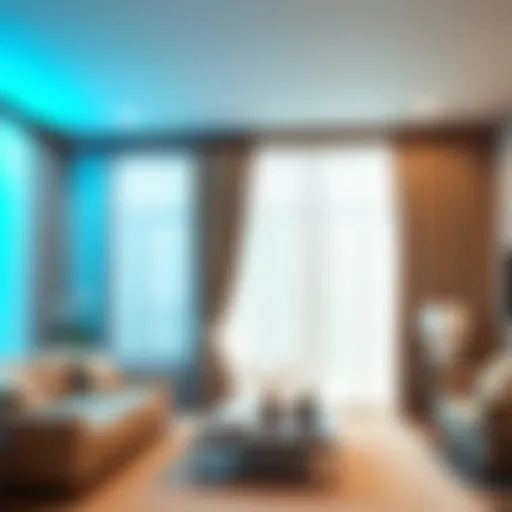Rugs: Design, Functionality, and Care Insights
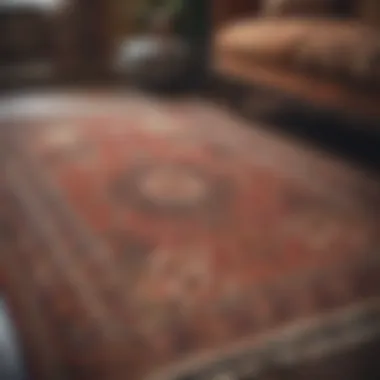

Intro
Rugs are more than just colorful fabric on the floor; they narrate stories of culture, function, and individual taste. For many homeowners and designers alike, understanding the multifaceted world of rugs is crucial. They can instantly transform a dreary space into a cozy retreat that feels welcoming. Yet, the choice of a rug goes beyond mere aesthetics. Factors such as materials, maintenance, and psychological impacts all play significant roles in the decision-making process.
In this exploration, we will dive into the intricate nature of rugs. The discussion ranges from design principles to care tips, from styles that make a statement to those that effortlessly enhance functionality. We’ll also unpack the subtle ways rugs can affect our mood and atmosphere within a room. Additionally, more conscious consumers will find insights into the environmental implications of rug production and ways to opt for sustainable choices. The goal is not only to enrich your understanding but to equip you with knowledge that allows for harmonious integration of rugs within your home.
Throughout the article, we will focus on the intersection of functionality and beauty, ensuring that whether you are a homeowner, a renter, a designer, or even a DIY enthusiast, there’s something valuable in this discussion for everyone.
The Role of Rugs in Interior Design
Rugs, often viewed as mere decorative pieces, actually play a pivotal role in interior design that extends far beyond aesthetics. They serve as the connective tissue, bringing together various elements within a room while offering both function and flair. Understanding their importance can elevate one’s approach to home décor, helping homeowners, renters, designers, and DIY enthusiasts achieve spaces that are not only visually appealing but also practical and inviting.
Aesthetic Contributions to Space
Color Enhancement
The vibrancy or subtlety of a rug can significantly influence the mood of a room. With color enhancement, rugs act as a pivot point for design choices, capturing attention and providing a focal area. For instance, a bold red rug can lively up an otherwise neutral space, instantly providing character. This key characteristic makes rugs incredibly versatile, allowing them to complement or contrast with existing decor.
However, while they can bolster beauty, the right color is essential. Selecting colors that clash or are too overwhelming can disrupt the overall harmony of the space. Therefore, it’s crucial to consider not just the hue but also the context in which the rug resides.
Pattern Dynamics
Patterns in rugs create a sense of movement and intrigue in a design. Be it geometric designs or floral motifs, the dynamic nature of patterns brings depth. They can articulate a narrative in spaces and help convey the stylistic preferences of the inhabitants. This characteristic is particularly significant as it allows for a wider expression of personality through décor.
However, bold patterns may lead to visual chaos if not properly balanced with furniture or other decor. Thus, while the unique feature of pattern dynamics enhances visual interest, it requires thoughtful pairing to avoid overwhelming the eye.
Texture Variation
Texture can elevate a rug from a mere design element to a tactile experience. From lush shag to flat-weave options, the variety in texture contributes to the comfort and warmth of a home. An intriguing texture can compel one to linger longer in a space, enhancing overall enjoyment. This is particularly beneficial in areas like living rooms or bedrooms where comfort is key.
Nevertheless, it’s important to note that certain textures may require additional maintenance or might not fit seamlessly with specific furniture styles. Unique textures can enthrall the senses but must be chosen with an eye for practicality.
Zoning and Space Definition
Open Concept Spaces
In recent years, open-concept layouts have become the darling of modern design. Rugs can be instrumental in defining spaces within these large, airy environments. By placing a rug under a dining table, for example, one can subtly delineate the eating area from the living space. This characteristic of rugs not only adds a functional element but is also aesthetically pleasing, blending different areas into a cohesive whole.
However, the open design can simultaneously lead to a lack of boundaries, so careful consideration of size and placement becomes paramount. A well-placed rug can create a sense of order, while a poorly chosen one might leave areas feeling disjointed.
Creating Intimacy
Another key aspect is the ability of rugs to instill a sense of intimacy in spaces. When placed strategically, a rug can define a cozy reading nook or an inviting conversation area. This perceived intimacy is vital for creating environments conducive to relaxation or social interaction.
The unique feature of fostering intimacy can be both a blessing and a curse. While a rug can enhance warmth, it can also crowd a small space if not selected wisely.
Functional Segmentation
Functional segmentation is an essential pattern of placement techniques for rugs. They can distinctly carve out areas within larger spaces for specific purposes, such as play areas for children or meditation zones. This feature is invaluable in versatile spaces that need to accommodate various activities.
However, it’s wise to approach segmentation with caution. Rugs that overlap or clash in design can send mixed signals about the purpose of each area. Therefore, selecting rugs that complement one another while marking distinctions is critical in maintaining a fluid design.
"Rugs are not just decorative; they harmonize colors, define spaces, and create feelings of comfort, making them an essential element in design."
In summary, the role of rugs in interior design is vast, encompassing aesthetic contributions and practical applications that cannot be overlooked. Homeowners and designers alike should consider these aspects as they curate their spaces.
Types of Rugs: Understanding Variations
Rugs are not just decorative pieces; they serve various purposes in the home while enhancing the aesthetic appeal and functionality of spaces. Understanding the different types of rugs allows homeowners and designers alike to make informed decisions that align with their needs and style preferences. By exploring categories such as area rugs, oriental rugs, shag rugs, and outdoor rugs, this section aims to provide clarity on their unique characteristics and benefits.
Area Rugs
Placement Techniques
Placement techniques of area rugs hold significant weight in creating a harmonious environment. The right placement can alter the perception of space, making a room feel more inviting or organized. Generally, a good rule of thumb is to ensure all furniture legs rest on the rug in a living room to achieve a cohesive look. A unique feature of this approach is its ability to define areas within open-concept designs, allowing for smoother transitions and clearer purposes for each zone.
The benefit of this technique lies in its versatility—whether it’s a large rug to anchor a dining area or a small one to accentuate a reading nook, placement sets the tone for the room. However, sometimes too-large or improperly placed rugs can make a space feel cramped and lose that elegant touch.
Style Choices
When it comes to style choices, area rugs can reflect personal taste while augmenting the overall decor. Common styles include modern, traditional, and bohemian, each offering distinct visual narratives. Choosing the right style can act as a focal point for a room, pulling together various elements like color schemes and furniture.
Key characteristic: area rugs often come in diverse patterns and textures. This variety means that homeowners can layer different designs for depth, creating a dynamic aesthetic. Yet, there's a caution: a mismatched rug style can clash with existing decor, leading to visual chaos.
Size Considerations
Size considerations are crucial for achieving balance in a room. A large area rug can unify a space, while smaller rugs might get lost or fail to make an impact. Finding the right ratio between rug size and room dimension encourages a visually appealing balance.
Unique feature: depending on a homeowner’s preference, a larger rug can define the area visually, giving an open feel to even the coziest corners. However, an excessively large rug can dominate a tiny space, making it feel cluttered—something to keep in mind when making choices.
Oriental Rugs
Cultural Heritage
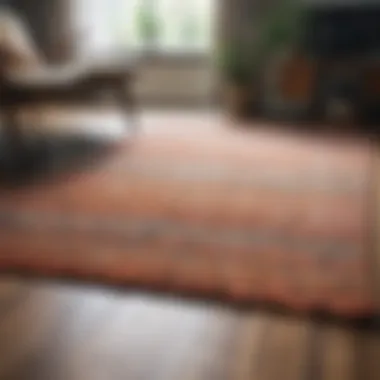

Oriental rugs carry rich cultural heritage that sheds light on their significance beyond mere decoration. These pieces, often associated with craftsmanship from specific regions like Persia or Turkey, encapsulate artistry that reflects the customs and history of their origin. Owning an oriental rug means carrying a piece of that heritage into one’s home, creating a conversation starter with guests.
Key characteristic: each rug tells a story through its patterns and motifs. They often represent emotions and tales of the weaver’s community. However, selecting an oriental rug requires understanding authenticity, as reproductions abound in the market.
Material Composition
Material composition plays a pivotal role in the durability and aesthetic of oriental rugs. Traditionally made from wool, silk, or cotton, these materials contribute to the tactile experience they offer. Wool blends provide resilience and warmth, while silk options exude luxury.
It's worth noting that authentic oriental rugs may have a higher price but are often seen as valuable investments due to their longevity and craftsmanship. Alternatively, cheaper materials may not deliver the same quality, resulting in a shorter lifespan.
Investment Value
The investment value of oriental rugs cannot be overlooked. Many collectors see these rugs as art pieces, appreciating them not just for their utility but for their potential to appreciate in value over time. Certain antique pieces, for instance, can fetch significant sums at auctions. Choosing an oriental rug can thus be seen not only as a design decision but a financial one as well.
Unique feature: investing in an oriental rug means investing in timeless beauty. However, potential buyers must be wary of the market's complexity, which includes determining authenticity and value in fluctuating trends.
Shag Rugs
Comfort Factor
Shag rugs are often the go-to for those seeking comfort. Their deep pile creates a plush feeling underfoot, adding warmth to any space. Especially in family rooms or bedrooms, they invite relaxation and coziness.
Key characteristic: the soft texture of shag rugs appeals to many, making them popular for casual settings. However, comfort can come at a cost; shag rugs can sometimes be more cumbersome to clean compared to flatter rugs, which brings us to the next consideration.
Maintenance Challenges
While shag rugs offer appeal, maintenance challenges are equally notable. Their long fibers can trap dirt and debris, requiring more frequent cleaning than others. Simple tasks like vacuuming may not suffice, often necessitating professional cleaning to maintain their condition.
Unique feature: despite their challenge, shag rugs can tolerate wear well if maintained correctly. Understanding this balance will help ensure the beauty remains intact over time.
Interior Compatibility
Considering their dynamic textures and styles, shag rugs can fit a variety of interiors. They are particularly well-suited for modern and eclectic designs, where bold patterns and colors can create visual interest.
However, there’s a downside. In formal settings, shag rugs may come off as too casual or less refined. Therefore, selecting the right kind of shag rug is essential to maintaining the intended vibe of a room.
Outdoor Rugs
Material Durability
Outdoor rugs must contend with elements like sun, rain, and foot traffic, making material durability a paramount aspect to consider. Many are made from synthetic fibers designed to withstand the rigors of outdoor environments, ensuring longevity despite exposure.
Key characteristic: utilizing materials such as polypropylene allows these rugs to resist fading and remain in good shape over time. However, not all outdoor rugs are created equal, and picking the right one for a particular climate is vital for ensuring its life span.
Weather Resistance
Weather resistance is often tied to a rug's intended use. As outdoor rugs are subject to varying climatic conditions, they must be crafted to resist moisture, fading, and mold growth. This characteristic plays a critical role in maintaining their appearance and functionality for outdoor living spaces.p>
Caution: some cheaper outdoor rugs may lure you in with lower prices but could end up failing beneath the harsh conditions, making it a poor investment over time.
Design Options
Outdoor rugs come in a plethora of design options, enabling homeowners to extend their style preferences outdoors. From bold colors to intricate patterns, there’s something for every patio or garden style.
Unique feature: they serve to unify external areas in the same way indoor rugs do. However, choosing an unsuitable design could result in mismatched aesthetics, undermining the outdoor living ethos.
Understanding the variations of rugs is an essential foundation for homeowners seeking to enhance their spaces. Each type offers unique elements, benefits, and considerations that contribute significantly to the integrity of home decor.
Materials Used in Rug Manufacturing
Materials used in rug manufacturing are important to understand for anyone looking to buy or maintain a rug. Different fibers come with a mix of performance, aesthetics, and environmental considerations. Knowing what a rug is made from helps in selecting the right one that not only fits your style but also your lifestyle.
Natural Fibers
Wool
Wool is one of the most cherished materials for creating rugs. Its natural resilience and softness make it a favored choice. Wool has an inherent ability to resist stains, thanks to its natural oils, which makes maintenance a bit easier. When you step on a wool rug, it feels warm and inviting underfoot.
One of the key characteristics of wool is its ability to retain heat, contributing to a cozy environment, especially in colder months. Though wool rugs tend to cost more, their durability and timeless appeal often justify the investment. However, keep in mind that wool requires careful cleaning to avoid shrinkage or damage.
Cotton
Cotton is another popular option, known for its breathability and lightweight feel. Rugs made from cotton are usually easier to maintain and can be machine-washed, offering convenience that wool does not.
However, while cotton is less expensive, it may not last as long as wool. One unique feature of cotton is its ability to hold dye well, which leads to vibrant color options. But on the flip side, cotton rugs might lose their shape over time and don’t offer the same warmth as wool.
Sisal
Sisal, made from agave plants, brings a unique earthy aesthetic to any room. It is quite durable, making it ideal for high-traffic areas. The natural texture of sisal adds depth to designs, offering a rustic touch.
One important characteristic of sisal is its hypoallergenic nature, making it a good choice for those sensitive to dust or allergens. However, this natural fiber is prone to staining and can feel rough underfoot, which might be a drawback for some.
Synthetic Fibers
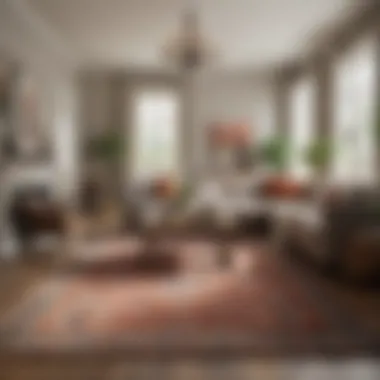

Nylon
Nylon rugs are recognized for their strong durability and high resilience. This fiber is excellent for high-traffic zones, as it withstands wear and tear better than most others. Its ability to bounce back after compression means that often traffic marks disappear.
Additionally, nylon retains color very well and has a softer texture, which appeals to many homeowners. However, synthetic fibers can sometimes lack the authenticity of natural materials, making them seem less cozy or warm in comparison.
Polyester
Polyester has gained popularity because it's cost-effective and soft underfoot. It’s known for its stain resistance and vibrant color retention, making it an attractive option for those wanting something bright and fun.
However, while polyester might mimic the look of natural fibers, it doesn't have the same durability. Over time, polyester rugs can mat down, especially with heavier furniture.
Polypropylene
Polypropylene is often favored for outdoor rugs because of its excellent resistance to moisture and fading. This fiber stands up well against the elements and is easy to clean, making it suitable for gardens and patios.
The downfall is that polypropylene might not have the same luxurious feel that wool or cotton offers. It can also generate static electricity, which is something to consider, especially in low-humidity environments.
Eco-Friendly Materials
Bamboo
Bamboo rugs are becoming more popular due to their sustainability. Bamboo grows rapidly and can be harvested without causing environmental damage, making it an eco-friendly option.
They offer a smooth feel and are lightweight, which can enhance the look of any space. However, bamboo can be prone to water damage and scratching, so careful placement is wise.
Recycled Textiles
Using recycled textiles for rugs is a great way to reduce waste. These rugs often come with unique designs, as they are made from various fabric pieces, making them a topic of discussion in any room.
They're usually less costly and environmentally friendly, however, the variability in materials can lead to inconsistencies in quality or durability, which is important to consider before purchasing.
Organic Wool
Organic wool elevates the typical wool rug, as it's sourced from sheep that graze on organic pastures. This makes it not only softer and more luxurious but also free from harmful chemicals.
The big advantage is that it’s kinder to the environment and provides a safe option for households, especially with small children or pets. On the downside, organic wool can come at a higher price and may require more specific care compared to conventional wool.
Psychological and Sensory Aspects of Rugs
Understanding the psychological and sensory impact of rugs plays a crucial role in how spaces are perceived and utilized. Rugs do not merely serve as functional items; they significantly shape the mood and comfort of a room. Their textures, colors, and patterns make them integral to creating environments that resonate with our emotions and senses. By focusing on these aspects, we can appreciate how rugs contribute to our well-being and the overall atmosphere of a home.
Influence on Ambiance
Warmth and Comfort
Warmth and comfort are essential factors when considering the ambiance of a space. A plush wool rug underfoot can transform a cold, sterile room into a cozy haven. The sensation of soft fabric beneath the feet creates a tangible feeling of comfort, inviting one to linger a little longer in the space.
This kind of warmth isn't just physical; it evokes emotional responses too. People often associate soft rugs with safety and relaxation, making them a preferred choice for living rooms and bedrooms. However, selecting the right material is crucial. While wool offers softness, it might not suit every homeowner's budget; synthetics could also do the job, but may not provide the same level of comfort.
Visual Cohesion
Visual cohesion refers to how elements in a room come together to form a harmonious whole. A well-chosen rug acts as a unifying factor, tying together disparate pieces of furniture and decor. For instance, a rug with colors that echo the hues found in walls or furnishings can produce an effect that feels curated rather than chaotic.
This aspect is particularly significant in open-plan spaces where defining areas visually can present a challenge. Rugs can delineate zones, giving structure to a layout. However, the challenge lies in balancing patterns; an overly intricate design might overwhelm the eye, while a simple one could lack personality. Striking the right balance is essential for visual coherence.
Sound Absorption
The acoustics of a room can greatly affect how we experience it. Rugs provide excellent sound absorption, reducing echo and noise levels, which is especially beneficial in homes with high ceilings or hard flooring. A thick shag rug, for example, can absorb sound and create a serene environment.
This feature not only enhances comfort but also contributes to a sense of peace, vital for resting spaces. On the flip side, while rugs can dampen sound, they can also trap allergens such as dust and pet dander, requiring regular maintenance. This balance between comfort and upkeep is an important consideration when selecting a rug.
The Textural Experience
Foot Comfort
The experience of walking on different rug materials varies greatly. Foot comfort significantly impacts how we perceive a space; a soft, supportive rug can make a room feel more inviting. Consider the experience of stepping onto a plush area rug after a long day—this tactile pleasure cannot be underestimated.
Many homeowners seek materials like wool or high-pile synthetic options for added comfort. The unique feature here is how different textures can influence not just comfort but also health. For example, softer rugs can be easier on the joints. Conversely, thin rugs might not provide the same level of cushioning and could lead to discomfort over time.
Touch Dynamics
Touch dynamics speak to the interaction one has with a rug. Different materials—be they plush, flat-weave, or shag—offer varied tactile sensations. This can stimulate a sensory response that enhances one's connection to the room.
For instance, the tactile experience associated with a jute rug differs markedly from that of a silky polyester piece. Each material presents its unique benefits and challenges, such as ease of cleaning or susceptibility to wear.
Those seeking a tactile experience that invites them to sit, lounge, or even play on the rug will need to consider what texture they wish to integrate into their home.
Interaction with Furniture
Rugs don’t exist in a vacuum; they interact with the furniture placed on top of them. How a rug complements or contrasts with nearby pieces can either enhance or detract from a room’s overall cohesion. For example, a modern sectional sofa might suit a geometric-patterned rug, while a traditional armchair could pair nicely with a more ornate design.
The height of the rug matters here too. A thick rug can make a lower piece of furniture like a coffee table feel more grounded, whereas a thinner rug can lend a sense of lightness. Great care must be taken to ensure that the proportion of the rug fits the size and scale of surrounding furniture to maximize both functionality and aesthetic appeal.
Care and Maintenance of Rugs
Maintaining the beauty and functionality of rugs is critical for any homeowner or renter. Proper care can extend the life of a rug, preserving its aesthetics while safeguarding the underlying floor. Whether you're dealing with a tactile shag rug or an intricate Oriental piece, understanding the nuances of rug care can have profound impacts on its longevity and your living space’s ambiance.
Maintaining rugs involves routine cleaning, addressing wear and tear, and considering seasonal factors. Each is important in its own right, yet they combine to form a comprehensive strategy. This topic is particularly relevant in today's fast-paced living environments where home decor can often reflect personal styles and also face considerable wear. In essence, a well-cared-for rug is not just a piece of decor; it becomes part of the home's character.
Routine Cleaning Techniques
Vacuuming Best Practices
Regular vacuuming is at the heart of routine cleaning. It prevents dirt and dust accumulation, which can grind fibers down over time. The key to effective vacuuming is using a vacuum that has adjustable settings for various rug types. For instance, high-pile rugs require a vacuum cleaner with a suction control or a beater bar that can be turned off to prevent damage.
An advantage of vacuuming regularly is that it can enhance the rug's appearance by lifting its fibers. However, some disadvantages may include occasionally pulling loose tufts, especially in delicate rugs, if the vacuum setting is incorrect. Thus, it is crucial to know your rug type and adjust accordingly – it’s like knowing how to dance with a partner, rather than pushing through with all your might.
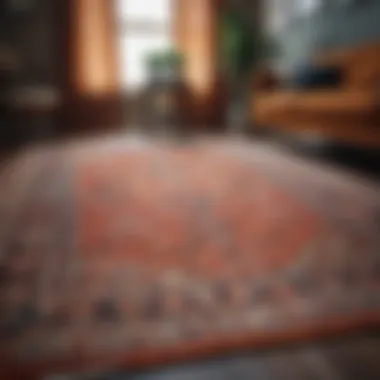

Spot Cleaning Methods
Spot cleaning is an essential quick-fix technique aimed at dealing with spills or stains as soon as they occur. The key aspect of spot cleaning is using the correct cleaning solution—usually a mild detergent mixed with water. Blotting the area instead of rubbing is particularly advisable to prevent spreading the stain or damaging the fibers.
This method is advantageous because it allows homeowners to address accidents immediately, maintaining the rug's overall look. However, an improper spot cleaning technique could lead to discoloration. Therefore, it's wise to always test the cleaner in an inconspicuous area before applying it broadly. Think of it as putting a little toe in the pool before diving in.
Professional Cleaning Options
When rugs accumulate grime or bad odors that at-home cleaning just can’t tackle, turning to professionals is often the best route. Professional cleaning services can offer tailored solutions based on the rug's material and construction. They employ techniques such as hot water extraction and shampooing, which can be particularly effective for deeply embedded dirt.
What makes professional cleaning a popular choice is the thoroughness that comes with experience. However, one downside is cost, as professional services can be pricey. Yet, when you have something valuable underfoot, sometimes it's worth investing in its upkeep to ensure longevity and a pristine look.
Addressing Wear and Tear
Fringe Repair
Fringing adds character to many rugs but is also prone to fraying and unraveling. Repairing these edges can enhance the rug's overall look and the appearance of the room. The key characteristic of fringe repair is that it can be done by hand, which makes it a popular choice among rug enthusiasts who appreciate craftsmanship.
A significant advantage of knowing how to repair fringes is that it prevents further damage from occurring. On the other hand, getting it wrong could worsen the appearance, so it's essential to approach these repairs with care and precision, much like threading a needle in dim light.
Patching Damages
Patching damaged areas of a rug involves sewing in matching patches or using fabric glue. This approach is crucial in preventing further damage by stopping frayed edges from expanding. The main characteristic of patching is its adaptability; it can renew a rug's life without the need for a complete overhaul.
A benefit of patching is that it can often be done at home, but it’s not a guaranteed fix. If the damaged area is substantial, it might require more professional help. Think of it as putting a band-aid on a cut—it works for small issues, but bigger problems need a doctor's touch.
Reweaving Techniques
Reweaving offers a more complex and long-lasting solution for damaged rugs, wherein the weaver uses materials similar to the original fibers to restore the rug back to its former glory. The key feature of this technique is its ability to blend in repairs seamlessly, making them almost invisible.
The distinct advantage of reweaving is that it preserves the integrity and value of the rug. Nonetheless, it can be time-consuming and requires expertise, so it’s not a task suited for everyone. Essentially, it's a labor of love, especially if the rug has sentimental value or is a family heirloom.
Seasonal Care Considerations
UV Protection
Direct sunlight can fade and damage rugs, especially those made from natural materials. Implementing UV protection, either through window treatments like curtains or using UV-resistant spray, is paramount. The key characteristic is the preventative approach, allowing for a long lifespan of the rug.
One excellent advantage of UV protection is that it can save the rug from irreversible damage. The downside, however, could be the added cost of treatments, but just like an umbrella on a rainy day, it’s better to be safe than sorry.
Humidity Management
Humidity can wreak havoc on rugs, especially if they are made from natural fibers. Areas with high humidity often see mildew growth and a general degradation of the rug’s quality. Managing humidity involves regulating indoor air conditions, typically using dehumidifiers or air conditioning.
The core benefit here is prevention; reducing moisture levels can fight against mold and bacteria. However, an overly dry environment can lead to fibers becoming brittle. So, it's about finding that sweet spot where both functionality and condition are optimized—like balancing a well-seasoned dish.
Storage Solutions
If you're considering switching out your rugs seasonally, having a solid storage solution is key. Roll up rugs instead of folding them to avoid creases. The key characteristic lies in using breathable garment bags to prevent dust build-up and protect against pest infestations.
A major advantage of good storage solutions is that they help maintain a rug's condition when not in use. Conversely, improper storage can lead to severe wear and tear during off-seasons, much like neglecting that prized plant over winter.
In summary, taking a comprehensive approach to rug care not only enhances their aesthetic appeal but also significantly contributes to their lifespan. By adhering to these guidelines, homeowners and renters alike can cultivate a living space that exudes both style and substance.
Sustainable Choices in Rug Purchasing
When it comes to selecting rugs, sustainability is no longer just a buzzword; it's becoming a fundamental concern for many consumers. With the growing awareness of environmental issues, choosing sustainable rugs plays a crucial role not just in aesthetics but also in advocating for an eco-friendly future. Sustainable rug purchasing can impact our homes while sending a strong message about our values. Beyond simply acquiring a product, these choices can contribute positively to the environment, economy, and communities.
Ethical Sourcing
Fair Trade Practices
Fair trade is all about ensuring that producers receive a fair payment for their work. This is important because it fosters a fairer global economy. Adopting fair trade practices in rug sourcing means that artisans are compensated fairly for their efforts, which isn't always the case in more traditional supply frameworks. The essence of fair trade lies in its commitment to equity and respect for workers. A notable characteristic is that consumers can often trace the origin of the rugs they purchase, promoting a deeper connection to the maker's story. However, some may argue that the price point for fair trade rugs can be steep. Still, it’s often seen as a worthwhile investment with the added benefit of supporting communities, creating jobs, and promoting local economies.
Supporting Local Artisans
Rugs made by local artisans bring uniqueness and character to spaces. Supporting these creators means investing in cultural heritage while ensuring that traditional craft methods are preserved. This practice promotes community development, allowing artisans to thrive economically while passing down their techniques to future generations. The incredible craftsmanship found in locally made rugs often reflects a rich cultural narrative. However, shoppers might encounter limited availability or elevated prices based on the artisan’s skill level, yet, the rarity and story behind each piece can justify the cost. By purchasing locally, you help keep traditions alive while enjoying a personalized touch that mass-produced items simply can't replicate.
Transparency in Production
Having transparency in rug production allows consumers to make informed choices about what they bring into their homes. Knowing the production methods, sourcing of materials, and working conditions is advantageous, as it builds trust between buyer and seller. When companies are open about their practices, it can also foster a sense of community; consumers feel they are part of a shared experience in supporting ethical businesses. A downside could be that some brands might not have thorough transparency, causing confusion regarding their manufacturing processes. Nonetheless, transparency is increasingly becoming a hallmark of reputable companies, influencing buyer decisions positively.
Eco-Conscious Design
Biodegradable Materials
Opting for rugs made from biodegradable materials can significantly reduce the environmental impact at the end stage of a product's life cycle. Materials such as wool or jute decompose over time, returning nutrients back to the earth. This characteristic makes biodegradable rugs particularly appealing to environmentally conscious consumers seeking to minimize waste. However, one drawback can be durability; while these materials may be more sustainable, they might require more care and not withstand wear as well as synthetic options. Yet, choosing biodegradable fibers leads to a healthier home environment and contributes to eco-friendliness.
Recyclable Options
Rugs produced from recyclable materials can play a key role in reducing landfill waste. By choosing rugs made from items that can be repurposed, consumers support circular economy practices. A key feature is that these rugs can often be reprocessed into new products rather than ending up in a landfill. The challenge may arise in finding a recycling facility for these items once they reach the end of their usable life. Nonetheless, the move toward recyclable options reflects a growing consumer demand for products that lessen environmental footprints, making them popular among eco-conscious buyers.
Sustainable Manufacturing Processes
Manufacturing processes that prioritize sustainability can lead to less water waste, decreased energy consumption, and reduced pollutive emissions. This makes the resultant rugs not just better for the environment, but often healthier for the home as well, as contaminants are avoided in production. A unique aspect of such processes is their innovative approach—think of companies using solar power or eco-friendly dye methods. However, the transition to more sustainable manufacturing may mean higher upfront costs for consumers. Yet, not only does this choice enhance the earth’s health, but it also promotes a market for progressive companies committed to change.
"Choosing sustainable rugs is not just about aesthetics. It’s about setting an example and being part of a story that values the environment, communities, and ethical practices."
Sustainable choices in rug purchasing shape our living spaces while influencing larger narratives of consumption. Each step toward more eco-friendly practices can resonate with the values of today’s conscientious consumers, helping to craft a world where homes, communities, and the planet can flourish together.







